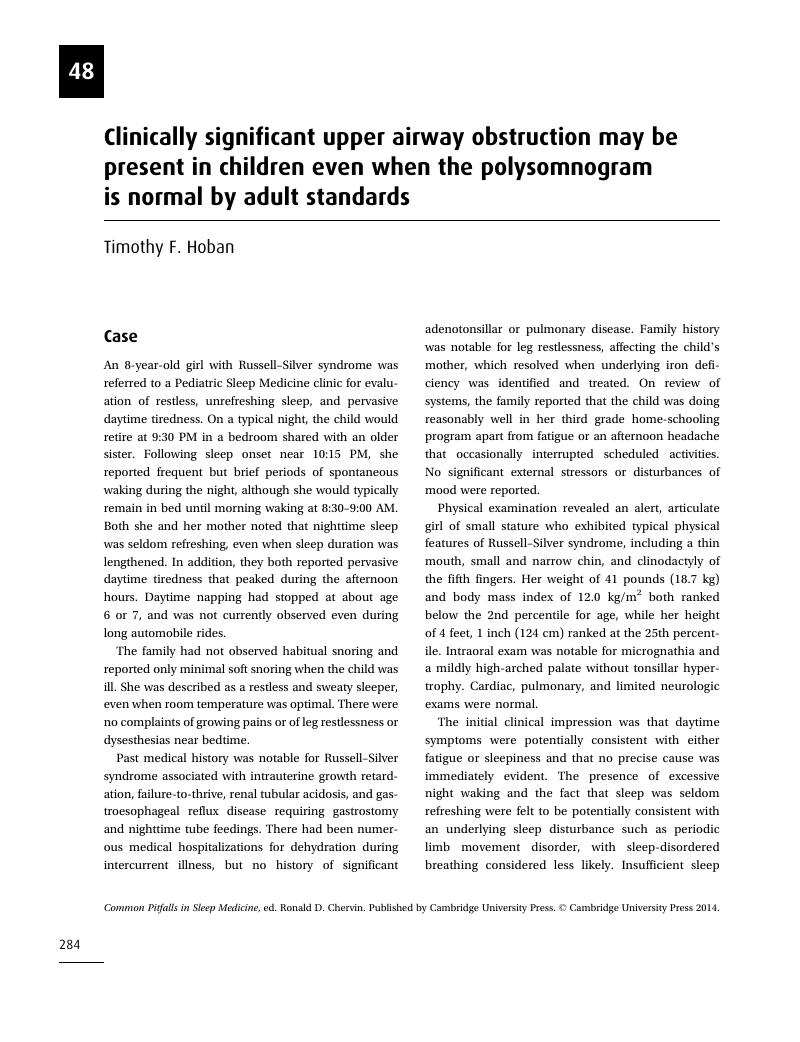Book contents
- Common Pitfalls in Sleep Medicine
- Common Pitfalls in Sleep Medicine
- Copyright page
- Contents
- Contributors
- Preface
- Acknowledgements
- 1 Introduction: the complexity, challenges, and rewards of effective sleep medicine
- Section one Sleepiness versus fatigue, tiredness, and lack of energy
- Section two Assessment of daytime sleepiness
- Section three Diagnosis of narcolepsy
- Section Four Diagnosis of obstructive sleep apnea
- Section Five Positive airway pressure to treat obstructive sleep apnea
- Section Six Alternatives to positive airway pressure in the treatment of obstructive sleep apnea
- Section Seven Diagnosis and treatment of chronic insomnia
- Section Eight Restless legs syndrome and periodic leg movements
- Section Nine Parasomnias
- Section Ten Circadian rhythm sleep disorders
- Section Eleven Missed diagnoses of obstructive sleep apnea can exacerbate medical and neurologic conditions
- Section Twelve Sleep in children
- 47 Sleepiness in childhood obstructive sleep apnea may be subtle but significant
- 48 Clinically significant upper airway obstruction may be present in children even when the polysomnogram is normal by adult standards
- 49 Low socioeconomic conditions can create substantial challenges to adequate sleep for young children
- 50 Inadequate sleep hygiene is a common cause of sleepiness in adolescents
- 51 Sleep and attention-deficit/hyperactivity disorder in children
- 52 Obstructive sleep apnea can occur without prominent snoring among children with Trisomy 21
- 53 Familiarity with infant sleep and normal variants can prevent extensive but unnecessary testing and intervention
- 54 Obstructive sleep apnea in patients with neuromuscular disorders
- Section Thirteen Sleep in older persons
- Index
48 - Clinically significant upper airway obstruction may be present in children even when the polysomnogram is normal by adult standards
from Section Twelve - Sleep in children
Published online by Cambridge University Press: 05 April 2014
- Common Pitfalls in Sleep Medicine
- Common Pitfalls in Sleep Medicine
- Copyright page
- Contents
- Contributors
- Preface
- Acknowledgements
- 1 Introduction: the complexity, challenges, and rewards of effective sleep medicine
- Section one Sleepiness versus fatigue, tiredness, and lack of energy
- Section two Assessment of daytime sleepiness
- Section three Diagnosis of narcolepsy
- Section Four Diagnosis of obstructive sleep apnea
- Section Five Positive airway pressure to treat obstructive sleep apnea
- Section Six Alternatives to positive airway pressure in the treatment of obstructive sleep apnea
- Section Seven Diagnosis and treatment of chronic insomnia
- Section Eight Restless legs syndrome and periodic leg movements
- Section Nine Parasomnias
- Section Ten Circadian rhythm sleep disorders
- Section Eleven Missed diagnoses of obstructive sleep apnea can exacerbate medical and neurologic conditions
- Section Twelve Sleep in children
- 47 Sleepiness in childhood obstructive sleep apnea may be subtle but significant
- 48 Clinically significant upper airway obstruction may be present in children even when the polysomnogram is normal by adult standards
- 49 Low socioeconomic conditions can create substantial challenges to adequate sleep for young children
- 50 Inadequate sleep hygiene is a common cause of sleepiness in adolescents
- 51 Sleep and attention-deficit/hyperactivity disorder in children
- 52 Obstructive sleep apnea can occur without prominent snoring among children with Trisomy 21
- 53 Familiarity with infant sleep and normal variants can prevent extensive but unnecessary testing and intervention
- 54 Obstructive sleep apnea in patients with neuromuscular disorders
- Section Thirteen Sleep in older persons
- Index
Summary

- Type
- Chapter
- Information
- Common Pitfalls in Sleep MedicineCase-Based Learning, pp. 284 - 289Publisher: Cambridge University PressPrint publication year: 2014

